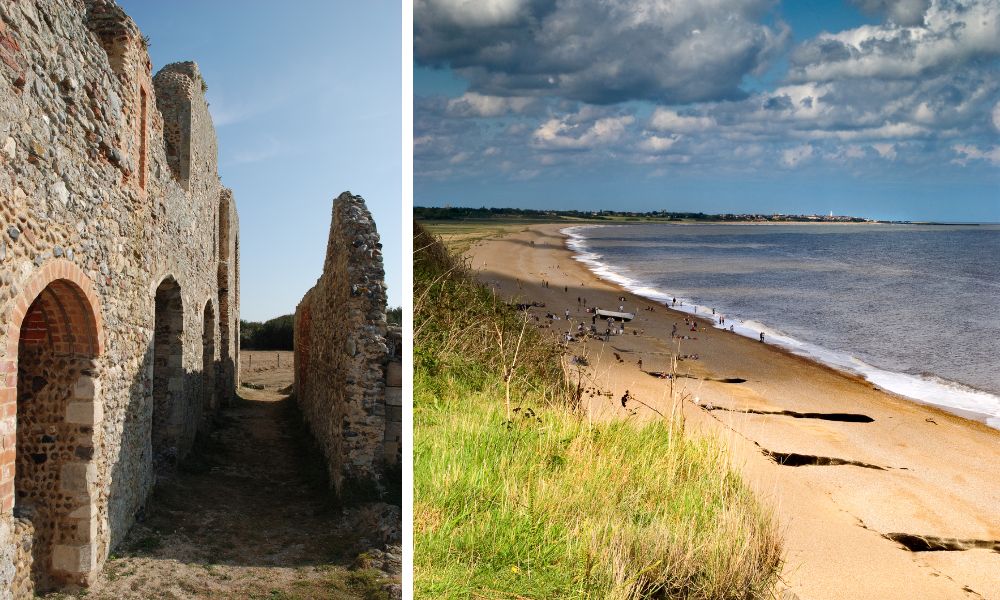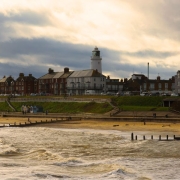We are no King Canute – but architects can help protect buildings from coastal erosion
Authorities have recently closed off Garisenda Tower – one of two medieval skyscrapers in Bologna, Italy—out of concerns that it may be sinking.
This isn’t the first historic building to fall at risk of the same fate, what with Venice’s slow descent into the seawaters that surround it, the same thing happening to New York City and cities like Jakarta, Rotterdam, Virginia Creek and Bangkok all facing the effects of rising sea levels. But unlike these, Garisenda isn’t coastal. The similarity however is related to water.
Subsidence like this is caused when large amounts of groundwater have been withdrawn from certain types of rocks, such as fine-grained sediments. The rock compacts so when the water is withdrawn, the rocks falls in on itself. For us, here in Suffolk, the coastal risk is a problem, however.
You only have to Google “Dunwich” to unearth (metaphorically of course) the lost city of England.
Once a thriving medieval port and on a par with London as the capital of the kingdom of East Anglia- with more than 3,000 residents recorded in 1086, the effects of storm surges and the resulting coastal erosion washed away much of the harbour buildings and land.

Research has been completed with sonar devices to map out the underwater streets and buildings of Dunwich’s past and many people say that during storms you can hear the bells of lost churches ringing from below the waves.
Of course, architects can’t exactly do a King Canute and order the tide to change. But we do play a large part in protecting historic buildings from coastal erosion.
Our role in coastal erosion
Climate change has been at the forefront of political conversations, as natural disasters occurring globally have been increasingly linked with human-induced climate change. Another consequence of climate change – a warming global climate – has caused sea levels to rise, as seawater takes up more space in the ocean base, and as the melting of ice over land adds water to the ocean.
To combat coastal erosion, property owners and coastal managers utilise the practice of shoreline armouring “ – using structures such as seawalls and breakwaters to stabilise coastal land. But these are often described as “eyesores”, awkwardly jutting out of the natural coastline and sometimes making beaches inaccessible. Over the last decade, however, many seaports – like South Boston and Amsterdam – have looked to architects and engineers to better reinvent the waterfront with imaginative urban planning. This might involve vacating new land into wetlands, introducing stormwater detention basins, rain gardens, floodable green infrastructures or implementing multi-purpose urban seawalls and investing in ecological parks by the coastline.
Future proof buildings
There are, of course, other ways to look at supporting communities who live by the sea. In East Yorkshire a proposal has been put forward to design sustainably for the future of coastline residents using prefabricated housing.
As modular and prefabricated construction techniques continue to advance, the potential to create high quality housing designed to continually move back from the coast has been suggested to form part of a solution to accommodate communities who have lost homes while encouraging new residents to promote growth and economy to locations of coastal decline.
Houses on stilts are also utilised in many areas – and we have several examples in Warlberswick, Suffolk.
The truth is that building a home on the coast is trickier than building on normal soil, so a pile or pier foundation is the most preferable. Open foundations present minimum obstruction for rising waters.
Buildings near the coast should also incorporate materials having high durability – towards moisture but also high winds. Using uPVC for windows is often preferable to use in marine environments over more traditional materials such as wood, aluminium or timber due to its more durable nature and ease of care.
There is no cast-iron guarantee when it comes to coastal architecture, however. But the architecture of climate change is likely to be the catalyst for the architect’s intervention and further innovation within infrastructure. It’s certainly an area of great interest in our sector – particularly for companies like ours established in areas by the sea.




